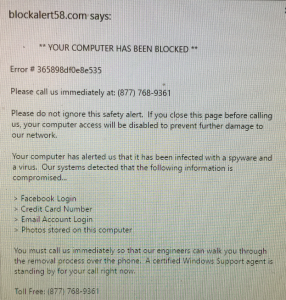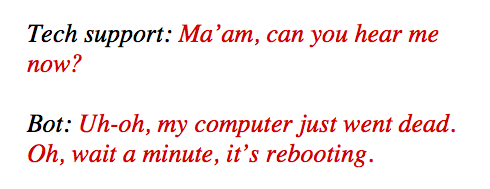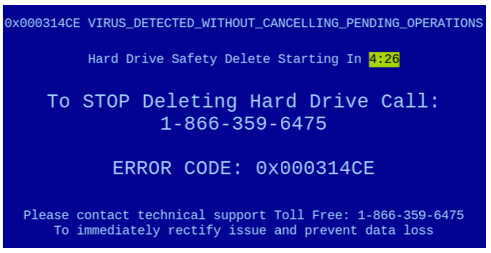Robot vs. tech support scammer—who will win?
- April 27, 2017
- Posted by:
- Categories: Archer News, Cyber Crime, Posts with image, Robotics

Robot army works to take down scam operations by phone.
Tech support scammers have taken thousands of victims—and millions of dollars—and the numbers are growing.
But a robot force is battling back.
At last count—the bot army has notched at least 10 tech support scam center takedowns, with more to come.
“Sometimes I’ll kill one off during my lunch break,” bot commander Roger Anderson told Archer News.
He kills them with words, and with calls.

The telecom consultant created his own brigade of recorded bot voices—under the umbrella of his pirate-themed Jolly Roger Telephone Company—that take on telemarketers and draw them out into long, time-wasting conversations.
He has now pointed that ship toward tech support scammers who pretend your computer is frozen and tell you to call an 800-number for technical help.
“I’ve got robots that sound like people, and I’ve got a real big phone system,” he said. “It crushes the call center.”

An example of a fake tech support message from Jolly Roger Telephone Company. Image via Jolly Roger Telephone Company.
How it works
Anderson’s bots call the scam center hundreds of times in a row.
“A legit victim can’t get through to the call center because I’m flooding the call center with robots,” Anderson said.
Not only that—in some cases, the call center will give up and shut down the phone number, according to Anderson.
The centers will most likely get a new number and open up again. But it takes time and resources. And that means less time and fewer resources to attack you.

Roger Anderson of the Jolly Roger Telephone Company. Image via Roger Anderson
Treasure
In the barrage of calls are gems, recorded interactions between bot and brazen scammer that leave the listener laughing.
After all, the bot is just a recording that responds automatically—and the results can be hilarious.
Tech support: What do you see on the computer screen?
Bot: I’m sorry, I’m sorry. I just have this huuuuge hangover and—
Tech support: Oh, you drunk?
Bot: I don’t know, just one of those nights, you know?
Tech support: You just drunk. I think you are drunk.
Bot: Drugs, alcohol, you know the deal.
Tech support: Oh, my God.
Bot: But can you start over again, please?
Tech support: Ha ha ha, okay.
Soon, the fake tech support agents are locked in a frustrating loop, unable to get a proper answer from someone who sounds very human, but just can’t quite answer the questions.

Anderson explained why the phone agents stay on the line for so long, despite the circular conversations.
“It’s clearly a person, and they must be confused,” Anderson said. “It’s an agreeable and friendly person. They’re not getting rattled. They’re agreeing to things. They’re listening.”
And they sound like they might be willing to pay up.
Tech support: Tell me, what do you see on your screen now?
Bot: Okay.
Tech support: Ma’am, do you see the Windows key on your key pad?
Bot: (Sigh)
Tech support: No?
Bot: This computer is so, so old, but it has everything on it. My entire life is on this computer. Can I just pay you to fix it?
Tech support: I will definitely fix it, ma’am, this with you. But before that, we need to go ahead and connect to your computer. All right?
Bot: Yep.

Not long after, the tech support agent decides to go for the money.
Tech support: Tell me, what is your credit card number?
Bot: (Sighs)
Tech support: Can you tell me, ma’am, what is your credit card number?
Bot: ‘Kay.
Tech support: Are you giving it to me or not?
Bot: Sure.

After five, ten, twenty minutes of verbal quagmire, the agent will hang up—or implode.
Tech support: Oh, my God! Nobody can fix your computer, ma’am!
Bot: Okay.
Tech support: All right. Yeah, nobody can fix your computer, okay?
Bot: Sure.
Tech support: What do you mean by ‘sure’? You fool! I mean, you are a fool, lady! You are a fool, lady. Tell me!
Bot: Okay.

Imagine if every call coming in to your scam center was this same kind fool. And every time you hang up, another seemingly half-witted but good-natured caller is on the line. And another. And another.
Anderson estimates his ship of fools has “knocked out” ten Windows support impersonator operations, as well as two Apple and ten IRS impersonator center numbers.
Denial of service
A recent study from Stony Brook University found more than 22,000 tech support scam webpages in 2015 and 2016, connected to more than 1,500 scam phone numbers.
Researchers surmised that more than 33,000 people fell victim, losing almost $10 million.

Researchers’ screenshot of tech support screen designed to make users believe their computer is infected. Image via “Dial One for Scam: A Large-Scale Analysis of Technical Support Scams“
Still, Anderson is concerned about his bot army’s war on tech support scams.
“I’m still struggling with the legal aspects of this,” he said. “I’m clearly conducting a ‘denial of service’ attack.”
A denial of service attack floods a business with so many calls or so much web traffic that the business can’t operate.
“Just because we all know these guys are scammers may not protect me completely,” he added.

Privateer
Anderson hopes someone will offer legal support.
“I’ve attracted the attention of several large companies that want to help me, but none have ponied up their legal team,” he explained.
“What I need is a ‘Letter of Marque’ from the trade or a regulatory body that turns this pirate into a privateer,” he said.
A letter of marque is a document governments gave to private ships to give them permission to capture enemy boats during wartime.
Pirates who captured ships were considered criminals, but privateers with letters of marque could take over ships legally, as they were acting on behalf of the government.

An 1817 letter of marque from Argentina’s government allowing privateer Hippolyte Bouchard to attack Spanish commerce ships. Image in the public domain via Wikimedia Commons
Scary
The latest tech support scam research concluded that criminals have no problem creating new fake web pages at a speedy rate, but the phone side is much harder.
“Interestingly, phone numbers cannot keep up with that growth, suggesting that curbing the abuse of phone numbers will have a significant effect on technical support scams,” the report said.

It would take more than one guy to do it, even if that guy has a bot army.
“It’s very time consuming to do it right and my day job is pretty demanding right now,” Anderson said.
He works on telephone systems for a living. And the idea of “breaking” the bad guy’s phone operation—even to stop criminals at work—can be nerve-wracking.
“I love telephone and I love telecom,” Anderson said. “It’s a little scary for me.”
You can hear more bot vs. tech support scam calls here and here.
